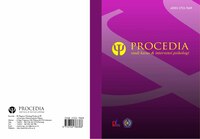Meningkatkan kemampuan pengucapan kata pada anak dengan Speech Sound Disorder
DOI:
https://doi.org/10.22219/procedia.v11i2.24441Keywords:
Child, play therapy, puzzle, speech sound disorder, word pronunciationAbstract
Speech sound disorder (SSD) is a disorder in the production of speech sounds in children. SSD can make it difficult for children to understand when speaking, interfering with verbal communication, social participation and academic achievement. The purpose of this study was to determine the effectiveness of play therapy using puzzles in improving children's word pronunciation skills with SSD. The assessment methods used are clinical interview, observation, and psychological test (WISC). As a result of this play therapy, subjects began to be able to remember and memorize letters of the alphabet correctly and began to be able to pronounce words such as "makan", and "ikan". Based on the interventions carried out, it can be concluded that play therapy with puzzle games can improve the ability to pronounce words in children who experience speech sound disorder correctly.
Speech sound disorder (SSD) adalah gangguan dalam produksi suara ucapan pada anak-anak. SSD dapat mempersulit anak untuk memahami saat berbicara, mengganggu komunikasi verbal, partisipasi sosial, dan prestasi akademik. Tujuan dari penelitian ini adalah untuk mengetahui efektivitas terapi bermain menggunakan puzzle dalam meningkatkan kemampuan pengucapan kata anak dengan SSD. Metode penilaian yang digunakan adalah wawancara klinis, observasi, dan tes psikologi (WISC). Hasil dari terapi bermain ini, subjek mulai dapat mengingat dan menghafal huruf abjad dengan benar dan mulai dapat melafalkan kata-kata seperti "makan dan "ikan". Berdasarkan intervensi yang dilakukan, dapat disimpulkan bahwa terapi bermain dengan permainan puzzle dapat meningkatkan kemampuan pengucapan kata pada anak yang mengalami speech sound disorder dengan benar.
Downloads
References
Aravamudhan, S., & Awasthi, S. (2020). Behavioral interventions to treat speech sound disorders in children with autism. Behavior Analysis in Practice, 13(1), 174–185. https://doi.org/10.1007/s40617-019-00362-5
American Psychiatric Association. (2013). Diagnostic and statistical manual of mental disorders: DSM-5 (Vol. 5, No. 5). Washington, DC: American psychiatric association.
American Speech Language Hearing Association. (2014). Speech sound disorders: Articulation and phonological processes. American Speech Language Hearing Association.
Campbell, T. F., Dollaghan, C. A., Rockette, H. E., Paradise, J. L., Feldman, H. M., Shriberg, L. D., Sabo, D. L., & Kurs‐Lasky, M. (2003). Risk factors for speech delay of unknown origin in 3‐year‐old children. Child Development, 74(2), 346–357. https://doi.org/10.1111/1467-8624.7402002
Drozdick, L. W., Raiford, S. E., Wahlstrom, D., & Weiss, L. G. (2018). The Wechsler Adult Intelligence Scale—Fourth Edition and the Wechsler Memory Scale—Fourth Edition. The Guilford Press.
Eadie, P., Morgan, A., Ukoumunne, O. C., Ttofari Eecen, K., Wake, M., & Reilly, S. (2015). Speech sound disorder at 4 years: Prevalence, comorbidities, and predictors in a community cohort of children. Developmental Medicine & Child Neurology, 57(6), 578–584. https://doi.org/10.1111/dmcn.12635
Farquharson, K., & Boldini, L. (2018). Variability in interpreting “educational performance” for children with speech sound disorders. Language, Speech, and Hearing Services in Schools, 49(4), 938–949. https://doi.org/10.1044/2018_LSHSS-17-0159
Fox, A. V, Dodd, B., & Howard, D. (2002). Risk factors for speech disorders in children. International Journal of Language & Communication Disorders, 37(2), 117–131. https://doi/abs/10.1080/13682820110116776
Furlong, L., Erickson, S., & Morris, M. E. (2017). Computer-based speech therapy for childhood speech sound disorders. Journal of Communication Disorders, 68, 50–69. https://doi.org/10.1016/j.jcomdis.2017.06.007
Hatiningsih, N. (2013). Play therapy untuk meningkatkan konsentrasi pada anak attention deficit hyperactive disorder (ADHD). Jurnal Ilmiah Psikologi Terapan, 1(2), 324–342. https://doi.org/10.22219/jipt.v1i2.1586
Hormansyah, R. D., & Karmiyati, D. (2020). Play therapy untuk meningkatkan atensi pada anak ADHD. Procedia: Studi Kasus dan Intervensi Psikologi, 8(2), 55-64. https://doi.org/10.22219/procedia.v8i2.13425
Khayati, F. N., & Pranandari, C. (2019). The influence of educative puzzle game to concentration of children with attention deficit and hyperactivity disorder in arogya mitra acupuncture klaten. Journal of Physics: Conference Series, 1179(1), 12129. https://doi.org/10.1088/1742-6596/1179/1/012129
Krueger, B. I. (2019). Eligibility and speech sound disorders: Assessment of social impact. Perspectives of the ASHA Special Interest Groups, 4(1), 85–90. https://doi.org/10.1044/2018_PERS-SIG1-2018-0016
Loeb, D. F., Davis, E. S., & Lee, T. (2021). Collaboration between child play therapy and speech-language pathology: Case reports of a novel language and behavior intervention. American Journal of Speech-Language Pathology, 30(6), 2414–2429. https://doi.org/10.1044/2021_AJSLP-20-00310
Mullen, R., & Schooling, T. (2010). The national outcomes measurement system for pediatric speech-language pathology.
Nelson, H. D., Nygren, P., Walker, M., & Panoscha, R. (2006). Screening for speech and language delay in preschool children: Systematic evidence review for the US Preventive Services Task Force. Pediatrics, 117(2), e298–e319. https://doi.org/10.1542/peds.2005-1467
Permatasari, A. U., & Tantiani, F. F. (2018). Puzzle dan suling untuk meningkatkan kemampuan bicara anak di TPA Early Grow Malang. SemNasPsi (Seminar Nasional Psikologi), 1(1), 144–155.
Ramadhani, H. S., Lestiawati, E., & Wahyuningsih, M. (2016). Pengaruh terapi bermain puzzle terhadap konsentrasi belajar anak kelas i di SD Negeri Pokoh 1 Ngemplak, Sleman, DI Yogyakarta. Medika Respati: Jurnal Ilmiah Kesehatan, 11(4). https://doi.org/10.35842/mr.v11i4.63
Reilly, S., Wake, M., Ukoumunne, O. C., Bavin, E., Prior, M., Cini, E., Conway, L., Eadie, P., & Bretherton, L. (2010). Predicting language outcomes at 4 years of age: Findings from Early Language in Victoria Study. Pediatrics, 126(6), e1530–e1537. https://doi.org/10.1542/peds.2010-0254
Rvachew, S., & Brosseau-Lapré, F. (2016). Developmental phonological disorders: Foundations of clinical practice. Plural Publishing.
Situmorang, M. A. (2012). Meningkatkan kemampuan memahami wacana melalui media pembelajaran puzzle. Kode: Jurnal Bahasa, 1(1). https://doi.org/10.24114/kjb.v1i1.146
Weis, J. E. (2020). Play therapy interventions promoting intrinsic characteristics of resilience. A systematic literature review.
Zareie Shamsabadi, N., Shahriar Ahmadi, M., Ghasisin, L., & Abedi, A. (2022). Relationship between speech sound disorders and neuropsychological skills with the mediating role of parenting styles and mother’s depression: Memory and visuospatial skills. The Scientific Journal of Rehabilitation Medicine, 10(6), 1194–1213. https://doi.org/10.32598/SJRM.10.6.6
Downloads
Published
How to Cite
Issue
Section
License
Copyright (c) 2023 Nidia Melanita

This work is licensed under a Creative Commons Attribution-NonCommercial 4.0 International License.






